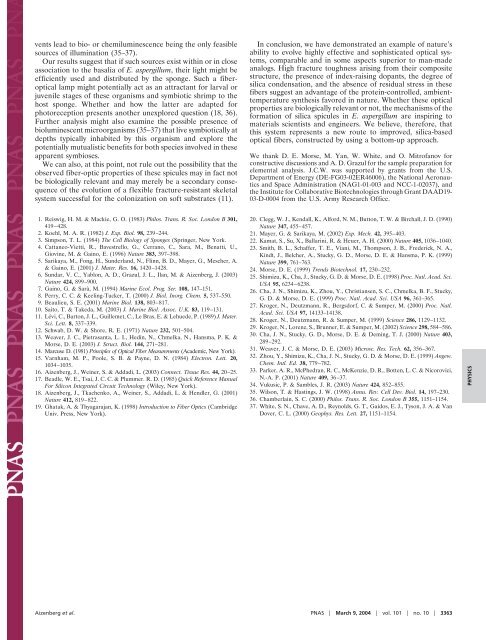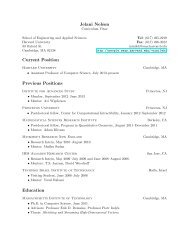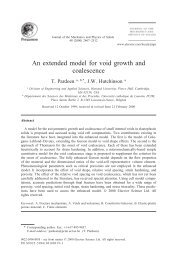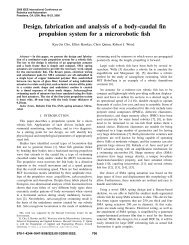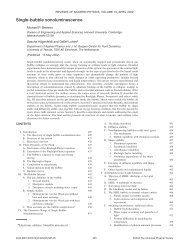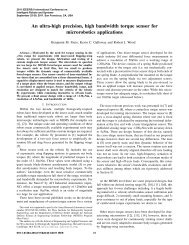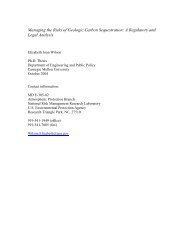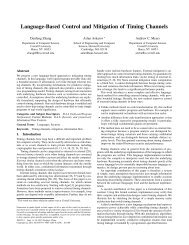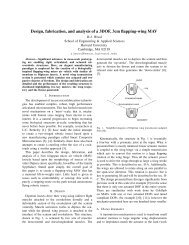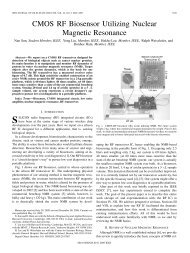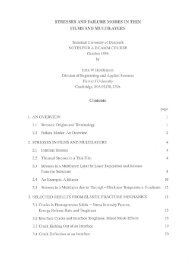Biological glass fibers: Correlation between optical and structural ...
Biological glass fibers: Correlation between optical and structural ...
Biological glass fibers: Correlation between optical and structural ...
Create successful ePaper yourself
Turn your PDF publications into a flip-book with our unique Google optimized e-Paper software.
vents lead to bio- or chemiluminescence being the only feasiblesources of illumination (35–37).Our results suggest that if such sources exist within or in closeassociation to the basalia of E. aspergillum, their light might beefficiently used <strong>and</strong> distributed by the sponge. Such a fiber<strong>optical</strong>lamp might potentially act as an attractant for larval orjuvenile stages of these organisms <strong>and</strong> symbiotic shrimp to thehost sponge. Whether <strong>and</strong> how the latter are adapted forphotoreception presents another unexplored question (18, 36).Further analysis might also examine the possible presence ofbioluminescent microorganisms (35–37) that live symbiotically atdepths typically inhabited by this organism <strong>and</strong> explore thepotentially mutualistic benefits for both species involved in theseapparent symbioses.We can also, at this point, not rule out the possibility that theobserved fiber-optic properties of these spicules may in fact notbe biologically relevant <strong>and</strong> may merely be a secondary consequenceof the evolution of a flexible fracture-resistant skeletalsystem successful for the colonization on soft substrates (11).In conclusion, we have demonstrated an example of nature’sability to evolve highly effective <strong>and</strong> sophisticated <strong>optical</strong> systems,comparable <strong>and</strong> in some aspects superior to man-madeanalogs. High fracture toughness arising from their compositestructure, the presence of index-raising dopants, the degree ofsilica condensation, <strong>and</strong> the absence of residual stress in these<strong>fibers</strong> suggest an advantage of the protein-controlled, ambienttemperaturesynthesis favored in nature. Whether these <strong>optical</strong>properties are biologically relevant or not, the mechanisms of theformation of silica spicules in E. aspergillum are inspiring tomaterials scientists <strong>and</strong> engineers. We believe, therefore, thatthis system represents a new route to improved, silica-based<strong>optical</strong> <strong>fibers</strong>, constructed by using a bottom-up approach.We thank D. E. Morse, M. Yan, W. White, <strong>and</strong> O. Mitrofanov forconstructive discussions <strong>and</strong> A. D. Grazul for the sample preparation forelemental analysis. J.C.W. was supported by grants from the U.S.Department of Energy (DE-FG03-02ER46006), the National Aeronautics<strong>and</strong> Space Administration (NAG1-01-003 <strong>and</strong> NCC-1-02037), <strong>and</strong>the Institute for Collaborative Biotechnologies through Grant DAAD19-03-D-0004 from the U.S. Army Research Office.1. Reiswig, H. M. & Mackie, G. O. (1983) Philos. Trans. R. Soc. London B 301,419–428.2. Koehl, M. A. R. (1982) J. Exp. Biol. 98, 239–244.3. Simpson, T. L. (1984) The Cell Biology of Sponges (Springer, New York.4. Cattaneo-Vietti, R., Bavestrello, G., Cerrano, C., Sara, M., Benatti, U.,Giovine, M. & Gaino, E. (1996) Nature 383, 397–398.5. Sarikaya, M., Fong, H., Sunderl<strong>and</strong>, N., Flinn, B. D., Mayer, G., Mescher, A.& Gaino, E. (2001) J. Mater. Res. 16, 1420–1428.6. Sundar, V. C., Yablon, A. D., Grazul, J. L., Ilan, M. & Aizenberg, J. (2003)Nature 424, 899–900.7. Gaino, G. & Sarà, M. (1994) Marine Ecol. Prog. Ser. 108, 147–151.8. Perry, C. C. & Keeling-Tucker, T. (2000) J. Biol. Inorg. Chem. 5, 537–550.9. Beaulieu, S. E. (2001) Marine Biol. 138, 803–817.10. Saito, T. & Takeda, M. (2003) J. Marine Biol. Assoc. U.K. 83, 119–131.11. Lévi, C., Barton, J. L., Guillemet, C., Le Bras, E. & Lehuede, P. (1989) J. Mater.Sci. Lett. 8, 337–339.12. Schwab, D. W. & Shore, R. E. (1971) Nature 232, 501–504.13. Weaver, J. C., Pietrasanta, L. I., Hedin, N., Chmelka, N., Hansma, P. K. &Morse, D. E. (2003) J. Struct. Biol. 144, 271–281.14. Marcuse D. (1981) Principles of Optical Fiber Measurements (Academic, New York).15. Varnham, M. P., Poole, S. B. & Payne, D. N. (1984) Electron. Lett. 20,1034–1035.16. Aizenberg, J., Weiner, S. & Addadi, L. (2003) Connect. Tissue Res. 44, 20–25.17. Beadle, W. E., Tsai, J. C. C. & Plummer. R. D. (1985) Quick Reference ManualFor Silicon Integrated Circuit Technology (Wiley, New York).18. Aizenberg, J., Tkachenko, A., Weiner, S., Addadi, L. & Hendler, G. (2001)Nature 412, 819–822.19. Ghatak, A. & Thyagarajan, K. (1998) Introduction to Fiber Optics (CambridgeUniv. Press, New York).20. Clegg, W. J., Kendall, K., Alford, N. M., Button, T. W. & Birchall, J. D. (1990)Nature 347, 455–457.21. Mayer, G. & Sarikaya, M. (2002) Exp. Mech. 42, 395–403.22. Kamat, S., Su, X., Ballarini, R. & Heuer, A. H. (2000) Nature 405, 1036–1040.23. Smith, B. L., Schaffer, T. E., Viani, M., Thompson, J. B., Frederick, N. A.,Kindt, J., Belcher, A., Stucky, G. D., Morse, D. E. & Hansma, P. K. (1999)Nature 399, 761–763.24. Morse, D. E. (1999) Trends Biotechnol. 17, 230–232.25. Shimizu, K., Cha, J., Stucky, G. D. & Morse, D. E. (1998) Proc. Natl. Acad. Sci.USA 95, 6234–6238.26. Cha, J. N., Shimizu, K., Zhou, Y., Christiansen, S. C., Chmelka, B. F., Stucky,G. D. & Morse, D. E. (1999) Proc. Natl. Acad. Sci. USA 96, 361–365.27. Kroger, N., Deutzmann, R., Bergsdorf, C. & Sumper, M. (2000) Proc. Natl.Acad. Sci. USA 97, 14133–14138.28. Kroger, N., Deutzmann, R. & Sumper, M. (1999) Science 286, 1129–1132.29. Kroger, N., Lorenz, S., Brunner, E. & Sumper, M. (2002) Science 298, 584–586.30. Cha, J. N., Stucky, G. D., Morse, D. E. & Deming, T. J. (2000) Nature 403,289–292.31. Weaver, J. C. & Morse, D. E. (2003) Microsc. Res. Tech. 62, 356–367.32. Zhou, Y., Shimizu, K., Cha, J. N., Stucky, G. D. & Morse, D. E. (1999) Angew.Chem. Intl. Ed. 38, 779–782.33. Parker, A. R., McPhedran, R. C., McKenzie, D. R., Botten, L. C. & Nicorovici,N.-A. P. (2001) Nature 409, 36–37.34. Vukusic, P. & Sambles, J. R. (2003) Nature 424, 852–855.35. Wilson, T. & Hastings, J. W. (1998) Annu. Rev. Cell Dev. Biol. 14, 197–230.36. Chamberlain, S. C. (2000) Philos. Trans. R. Soc. London B 355, 1151–1154.37. White, S. N., Chave, A. D., Reynolds, G. T., Gaidos, E. J., Tyson, J. A. & VanDover, C. L. (2000) Geophys. Res. Lett. 27, 1151–1154.PHYSICSAizenberg et al. PNAS March 9, 2004 vol. 101 no. 10 3363


